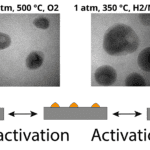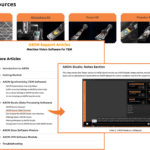
 Electrochemical measurements are an indispensable tool for many applications, including material analyses, sensors, manufacturing processes and energy storage. Due to the high demand for these products to become more efficient, there is an increasing need to observe these materials at the nanoscale, in real time. To observe these reactions, in-situ and operando TEM studies using electrochemistry combined with liquid phase electron microscopy is used. How can the Poseidon AX be used in electrochemical reactions? In order to perform electrochemical measurements inside the TEM during an operando study, it is necessary to utilize an in-situ holder with electrochemical capabilities. The Poseidon AX system isolates the sample and its environment from the high vacuum of the TEM column by enclosing it between a pair of semiconductor MEMs devices called E-chips.
Electrochemical measurements are an indispensable tool for many applications, including material analyses, sensors, manufacturing processes and energy storage. Due to the high demand for these products to become more efficient, there is an increasing need to observe these materials at the nanoscale, in real time. To observe these reactions, in-situ and operando TEM studies using electrochemistry combined with liquid phase electron microscopy is used. How can the Poseidon AX be used in electrochemical reactions? In order to perform electrochemical measurements inside the TEM during an operando study, it is necessary to utilize an in-situ holder with electrochemical capabilities. The Poseidon AX system isolates the sample and its environment from the high vacuum of the TEM column by enclosing it between a pair of semiconductor MEMs devices called E-chips.
Each E-chip contains an ultrathin, electron transparent membrane which forms a viewing window. The working, counter and reference electrodes are patterned onto the E-chip surface. An external potentiostat delivers and measures the electrochemical stimuli and resulting output through the shaft of the sample holder.
What are the main limitations of the system?
Due to limitations imposed by the spatial dimensions required for TEM sample holders; electrodes patterned onto the E-chip for in-situ/operando TEM experiments must be compatible with semiconductor lithography processes. This miniaturization of electrochemical reactions means that there is a limitation in the fabrication of different reference electrodes (REs). So far, most systems work with platinum REs, which serve as a pseudoreference. The major issues with this are:
- The platinum pseudo-reference can lead to a large amount of uncertainty (~0.1V) in measured potentials
- Due to the use of a pseudo-RE, there are limitations in comparison with bulk results using standard REs
How can these limitations be overcome?

To overcome the limitations of an on-chip pseudo-RE, we have developed an external reference electrode solution designed to pair with the Poseidon AX system. This setup can utilize any number of commercially available electrodes, allowing the user the ability to employ conventional REs and eliminate crosscontamination of their experiment from the RE. The setup consists of a shielded metal bridge connecting the on-chip reference electrode to an external electrolyte solution containing a commercial reference electrode. The external RE is insulated from noise and interference through a dedicated Faraday cage with pass-throughs that minimize mechanical and electronic interference. In this arrangement, the metal bridge acts as the conducting bridge between the active electrochemical cell inside the microscope and a shielded electrolyte cell containing the reference electrode located externally to the microscope.
If you want to read more about how the standard RE works, you can read more in this article:
https://iopscience.iop.org/article/10.1149/1945-7111/aca367









